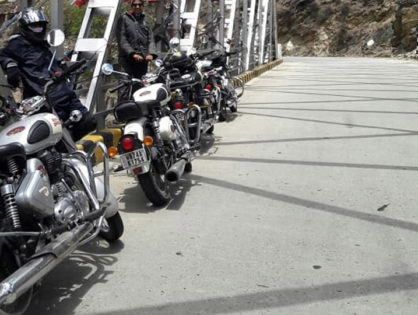As we all know, the helmet is the most important equipment on a rider’s list of guards and protectors. Choosing the one that suits the very purpose of protecting your head is of utmost importance rather than it being fashionable or stylish. Sheetal Bidaye lists down 10 tips for choosing the best helmet for you.
First and foremost, never ever buy a used helmet! A damaged piece might not always show any visible signs of damage and you may land up risking your head and life trying to save on a few bucks.
Understanding the helmet
The helmet is made of a hard outer shell, a crushable interior foam lining, a comfort lining and a chin-strap.
The rigid outer shell is strong and provides abrasion resistance while protecting your head from any foreign object while the interior foam lining is specially designed to absorb and disseminate impact. Inside the top two layers is a soft padded lining which gives a snug fit while keeping you comfortable. The chin-strap is a retention system which makes sure the helmet stays in place.
Outer shell
Most manufacturers use fibreglass or lightweight plastic for the outer shell while the high-end ones have materials like Kevlar or carbon-fibre which are light-weight yet expensive. Choose one that suits your purpose best without compromising quality.
Foam Lining
Most critical ingredient of motorcycle safety is the interior foam lining. Most manufacturers use EPS (Expanded Polystyrene) foam which is lightweight and rigid yet crushable. During impact, the liner absorbs and disperses the force which would otherwise hit the skull and cause brain damage. Some helmets have dual foam liners with various depth and densities offering enhanced protection.
Padded lining
It is always better to choose a helmet with a removable and washable liner. Washing the liner will help deliver the best comfort and a proper fit since sweat and chemicals in hair products cause damage to it.
Chin-strap
The Chin-strap helps keep the helmet in place while you ride your motorcycle. It is essential that the helmet does not move or gets lopsided which may result in a serious crash injury. You may choose for chinstraps with D-rings, adjustable buckles or those with micrometric adjustment retention systems.
Safety Standards
While choosing a helmet you need to be aware of industrial standards that motorcycle helmets must conform to i.e. DOT, ECE, Snell, BSI etc. which are agencies that test and certify a helmet’s ability to protect your brain against trauma caused by an uneventful crash. All countries have their own helmet rating systems and standards. Riders should be aware of fraudulent vendors who just slap a fake ECE sticker and sell low grade helmets.
Choose your style
Although some of us may enjoy the feel of wind on our faces and prefer half face helmets, it’s the least kind of protection you give yourself and you ought to understand that wherever the wind makes contact, the road may too! Apart from that, your face is being exposed to natural elements, leaves, bugs and debris which may hinder concentration and negatively affect your riding comfort.
Full face helmets offer most protection from all of the above hazards while keeping you comfortable. Since most of them come with the added benefit of aerodynamics, they reduce riding fatigue too. If you are thinking of fashion, which obviously come secondary to safety, full-face helmets are available in many different varieties and brands to suit your choice of colours and style.
Flip-up or modular helmets offer protection from elements the way a full-face helmet would but not the same degree of protection. Again, available to suit various style and colour preferences.
A perfect fit
Choose a helmet which fits your head snugly. Try to push your little finger between the helmet and your forehead. Ideally, you should not be able to get more than its tip in. If that’s the case, this is the right helmet for you. The helmet should be firm and tight yet not cause any discomfort. The helmet should make contact all over your head and if you try moving it around, your scalp should move too.
Clarity of vision
The helmet you choose must have a high quality face shield or visor. There are types of visors too (as if the hard-work of choosing the right shell wasn’t enough!) Some are injection moulded and are optically perfect while others are bent to shape and suit the helmet but these create distortions in vision. While choosing your helmet, wear it and note the amount of peripheral vision. A good visor must not fog up easily when worn (you get anti-fog visors too). For long distance riding you may opt for helmets with an internal sun visor which enables you to switch to a dark face shield in bright sunlight or switch back to the clear visor in the evening.
Ventilation
Vents around the helmet are very important since the fresh airflow not only adds to your comfort while riding but helps in diluting the exhaust built inside. A chin vent is a must along with top vents that push air around the head. Many helmets come with vents in the rear too which help in expelling the air from inside keeping your head cool and comfortable. The best venting helmets have holes in the inner liner that synchonise with the vents on the shell.
Wisely choose your helmet to give you the best fit and comfort – indirectly, the best protection. Invest in a few additional bucks and if properly cared for, your helmet should last for a good 5 years.



